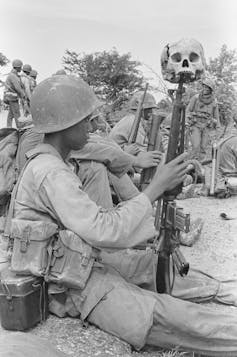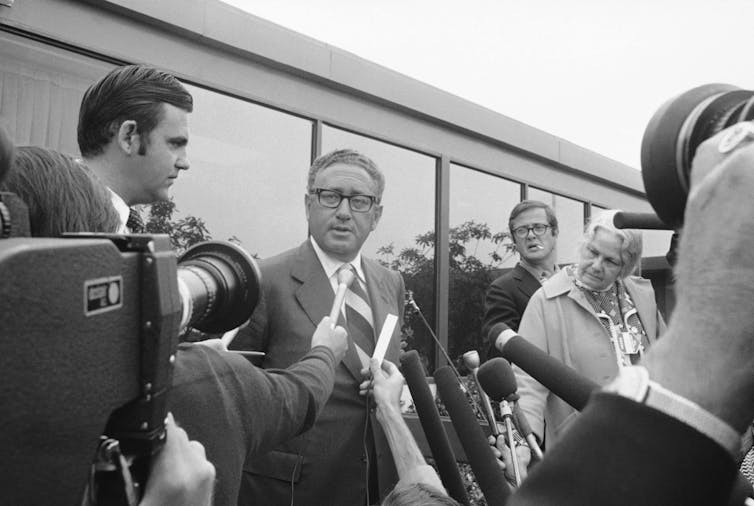Henry Kissinger’s bombing campaign likely killed hundreds of thousands of Cambodians − and set path for the ravages of the Khmer Rouge
Henry Kissinger, who died on Nov. 29, 2023 at the age of 100, stood as a colossus of U.S. foreign policy. His influence on American politics lasted long beyond his eight-year stint guiding the Nixon and Ford administrations as national security adviser and secretary of state, with successive presidents, presidential candidates and top diplomats seeking his advice and approval ever since.
But his mark extends beyond the United States. Kissinger’s policies in the 1970s had immediate impact on countries, governments and people across South America, the Middle East and Southeast Asia. Sometimes the fallout – and it was that – lasted decades; in some places it continues to be felt today. Nowhere is that more true than Cambodia.
I’m a scholar of the political economy of Cambodia who, as a child, escaped the brutal Khmer Rouge regime with four siblings, thanks in large part to the cunning and determination of my mother. In both a professional and personal sense, I am aware of the near 50-year impact Kissinger’s policies during the Vietnam War have had on the country of my birth.
The rise of the murderous regime that forced my family to leave was, in part, encouraged by Kissinger’s policies. The cluster bombs dropped on Cambodia under Kissinger’s watch continue to destroy the lives of any man, woman or child who happens across them. Indeed, when the current U.S. administration announced its intention in 2023 to provide cluster bombs to Ukraine, the prime minister of Cambodia was quick to call out the lingering damage the munition causes.
‘Island of peace’
Counterfactuals are not the best tool of the historian; no one can say how Cambodia would have developed were it not for the Vietnam War and U.S. intervention in Southeast Asia.
But prior to the U.S. bombing of Cambodia, the country was touted as an “Island of Peace” by then-leader Prince Norodom Sihanouk, with a developing economy and relative stability.
After Cambodia gained independence from its French colonial masters in 1953, Sihanouk presided over what was seen as a golden age for Cambodia. Even Lee Kuan Yew, the founder of modern-day Singapore, visited Cambodia to learn lessons on nation-building.
The country’s independence from France did not require any hard fight. Neighboring Vietnam, meanwhile, gained independence only after the bitter anti-colonial First Indochina War, which concluded with a rout of French troops at Điện Biên Phủ in 1954.
However, Cambodia’s location drew it into the subsequent war between the newly independent communist North Vietnam and U.S.-backed South Vietnam.
Cambodia wasn’t officially a party in the Vietnam War, with Sihanouk declaring the country neutral. But Washington looked for ways to disrupt communist North Vietnamese operations along the Ho Chi Minh Trail – which cut across Cambodia’s east, with Sihanouk’s blessing, and allowed the resupply of North Vietnamese troops on Cambodian soil.
Kissinger’s ‘menu’
Kissinger was the chief architect of the plan to disrupt that supply line, and what he came up with was “Operation Menu.” The secret carpet-bombing campaign – with breakfast, lunch, dinner, snack, dessert and supper representing different targets and missions within Cambodia – was confirmed at a meeting in the Oval Office on March 17, 1969. The diary entry of Richard Nixon’s chief of staff, H. R. Haldeman, reads: “ … Historic day. K[issinger]‘s 'Operation Breakfast’ finally came off at 2:00 pm our time. K really excited, as is P[resident].”
The following day, Haldeman wrote: “K’s ‘Operation Breakfast’ a great success. He came beaming in with the report, very productive.”
And so began four years of Kissinger’s legally dubious campaign in Cambodia.
To Kissinger, Cambodia was a “sideshow,” to use the title of William Shawcross’ damning book exposing the story of America’s secret war with Cambodia from 1969 to 1973.
During that period, the U.S. bombing of neutral Cambodia saw an estimated 500,000 tons of ordnance dropped on 113,716 targets in the country.
Secret and illegal war?
Kissinger and others in the White House tried to keep the campaign from the public for as long as they could, for good reason. It came as public opinion in the U.S. was turning against American involvement. The bombing campaign is also considered illegal under international law by many experts.
But to Kissinger, the ends – containing communism – seemingly justified the means, no matter the cost. And the cost to Cambodians was huge.
It resulted in the direct deaths of hundreds of thousands of Cambodians. With the U.S. government keeping the bombings secret at the time, comprehensive data and documentation are limited. But estimates on the number of deaths range from as few as 24,000 to as many as a million. Most estimates put the death toll in the hundreds of thousands.
Kissinger’s campaign also destabilized Cambodia, leaving it vulnerable for the horrors to come. The capital, Phnom Penh, ballooned in population because of the displacement of more than a million rural citizens fleeing U.S. bombs.
Meanwhile, the bombing of Cambodian citizens contributed to an erosion of trust in Camodia’s leadership and put at question Sihanouk’s policy of allowing the North Vietnamese access through the country’s east. On March 18, 1970, Sihanouk was ousted in a coup d’etat and replaced by the U.S.-friendly Lon Nol. Direct U.S. involvement in the coup has never been proven, but certainly opponents to Lon Nol saw the hand of the CIA in events.
The ousted Sihanouk called on the country’s rural masses to support his coalition government in exile, which included the Khmer Rouge. Until then, the Khmer Rouge had been a ragtag army with only revolutionary fantasies. But with Sihanouk’s backing, they grew. As journalist Philip Gourevitch noted: “His name became the Khmer Rouge’s greatest recruitment tool.”
But Kissinger’s bombs also served as a recruitment tool. The Khmer Rouge were able to capitalize on the anger and resentment of Cambodians in the areas being shelled. Rebel leaders portrayed themselves as a force to protect Cambodia from foreign aggression and restore order and justice, in contrast to the ruling government’s massive corruption and pro-American leanings.
Kissinger’s bombing campaign was certainly not the only reason for the Khmer Rouge’s rise, but it contributed to the overall destabilization of Cambodia and a political vacuum that the Khmer Rouge was able to exploit and eventually seize power – which it did in 1975, overthrowing the government.
Led by Pol Pot, the Khmer Rouge inflicted unimaginable atrocities upon the Cambodian people. Its genocidal campaign against political opponents, Cambodian minorities and those deemed counterrevolutionaries saw between 1.6 and 3 million people killed through executions, forced labor and starvation – a quarter of the country’s then population.
The scars from that period are still felt in Cambodia today. Recent research even points to the economic impact Kissinger’s bombs continue to have on farmers, who avoid richer, darker soil over fears that it hides unexploded ordnance.
Anti-Americanism is no longer prevalent at the everyday level in Cambodia; indeed, the opposite is increasingly becoming true as China’s financial and political embrace becomes suffocating. But anti-Americanism is frequently used in rhetoric by leading politicians in the country.
I don’t agree with some other scholars that Kissinger’s bombing campaign can be definitively proven to have resulted in Khmer Rouge rule. But in my view, it no doubt contributed. Hun Sen, Cambodia’s autocratic leader who ruled for 38 years before passing the prime minister baton to his son in August 2023, has cited the U.S. bombing of his birthplace as the reason he joined the Khmer Rouge. Many others joined for similar reasons.
As such, the devastating impact of Kissinger’s policies in Cambodia cannot be overstated – they contributed to the unraveling of the country’s social fabric and the suffering of its people, leaving behind a legacy of trauma.
This article was amended on Dec. 4, 2023, to revise the estimate of tonnage of ordinance dropped on Cambodia in U.S. bombing campaign.
https://theconversation.com/henry-kissingers-bombing-campaign-likely-killed-hundreds-of-thousands-of-cambodians-and-set-path-for-the-ravages-of-the-khmer-rouge-209353



No comments:
Post a Comment
Note: Only a member of this blog may post a comment.